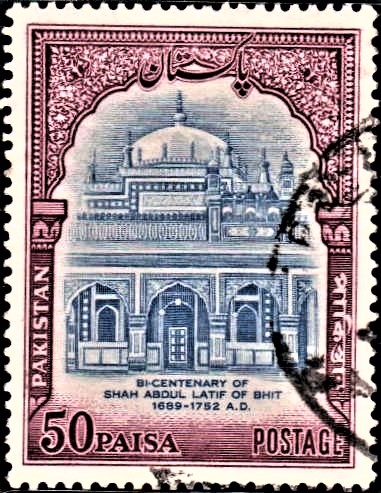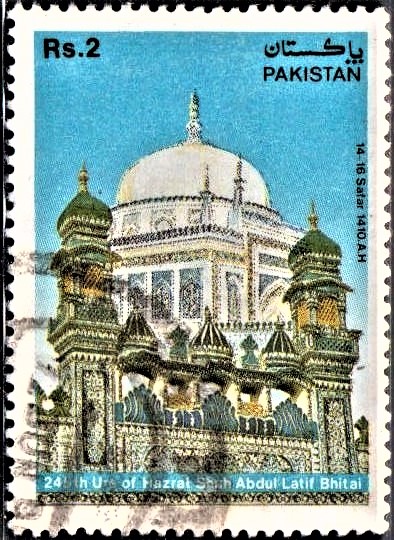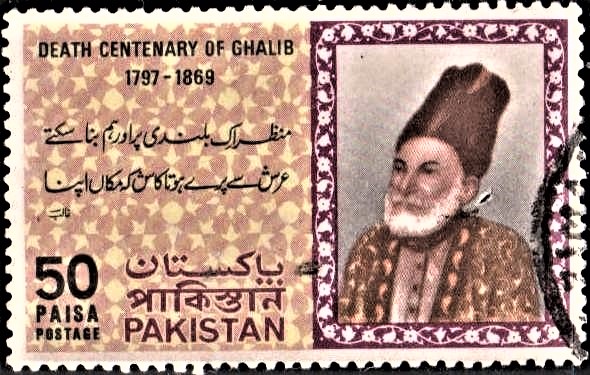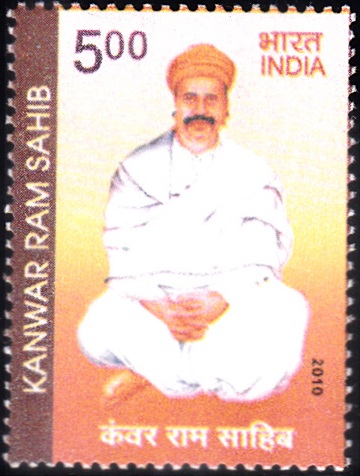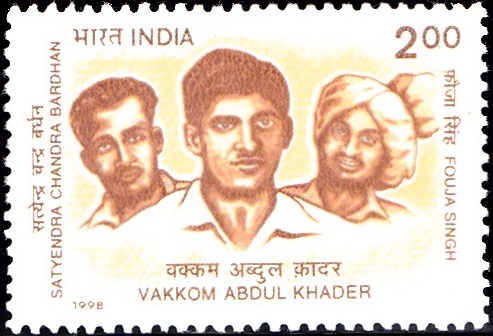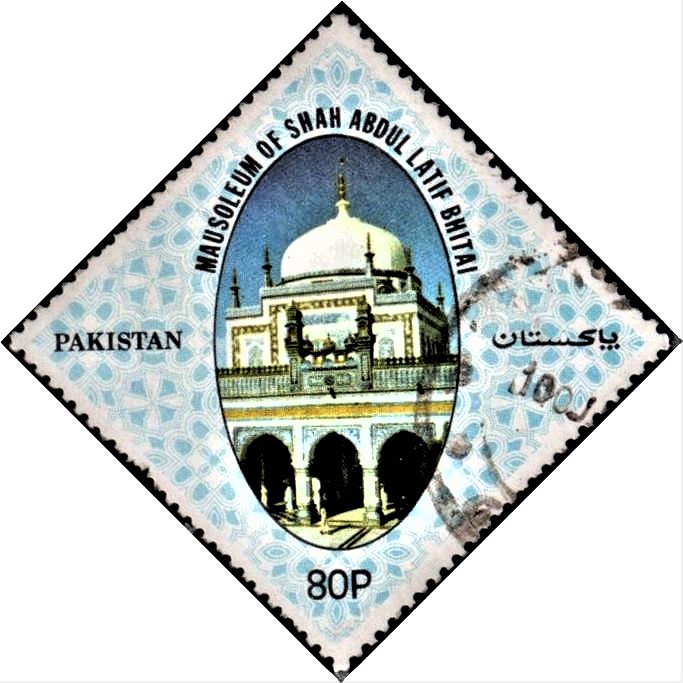
Hazrat Shah Abdul Latif Bhitai
A commemorative postage stamp on the Shah Abdul Latif Bhitai Mausoleum :
 Issued by Pakistan
Issued by Pakistan
Issued on Oct 8, 1987
Issued for : To commemorate Hazrat Shah Abdul Latif Bhitai, Pakistan Post Office is issuing a stamp of 80 Paisa denomination on October 8, 1987.
Designer : Adil Salahuddin
Type : Stamp, Postal Used
Denomination : 80 Paisa
Colours : Yellow, Red, Blue and Black
Size of Stamp : 40 x 40 mm
Size of Print : 37 x 37 mm
Perforation : 13C
Quantity : 500,000
Number of stamps in a sheet : 50 (fifty)
Process of Printing : Litho Offset
Printer : Pakistan Security Printing Corporation
Name : Shah Abdul Latif
Born on Nov 18, 1689 at Sui–Qandar (Bhit Shah) Hala, Sindh, Pakistan
Died on Jan 1, 1752 at Bhit Shah, Sindh, Pakistan
About :
- Shah Abdul Latif, the most popular and versatile poet of Sindhi language and the greatest exponent of Sindhi Sufi thought and Sindhi traditions, was born in 1689 A.D. in Hala Haveli, presently a township in Hyderabad District. By Decent he belonged to an already well-known and highly esteemed Jararpota Sayyad family of Sind which also had a traditional reputation as having produced poets. Shah of Sindh, was one of his ancestors.
- The themes and the contents of his poetry show the great dimensions of his genius for Sindhi poetry and overshadow the formal education of his times that he must have received which at that time included the study of Quran and Theology and learning of Arabic and Persian languages.
- His sufistic longings took him to Lasbela and parts of Makran in Balochistan, which brought him contact with all sections of the people, the poor villagers, artisans, farmers, the sons of the desert in the South-East of Sind, and the mountaineers in its west, where he discovered the life and traditions, worries and sorrows, the hopes and aspirations of the people: thus also he came to explore the spiritual side of other modes of life, particularly Hinduism, and associate himself with the Sadhus of various Hindu sects, and visited the Ganja Mount in Sind, Mount Girnar in Kathiawar and Nani in Makran. The variety of his experiences made him acutely aware of the Essence beyond the veil of the ceremonials: the Essence, according to him, consists of love for the creator and the fellow human beings. He retired to lonely prayers and long solitudes to experience the truth at the higher spiritual levels: from these he emerged imbued with love for humanity. He imparted his experiences to others through his verses which eventually reached every hut and hamlet in the country: he built a new abode for himself and his associates on sand-dune called Bhit in Sindhi and thereby came to be known to the people all around as Bhitai i.e. of the Bhit.
- The years of his life marked the turning point in the history of the Indo–Pak subcontinent and also that of Sind. By the time he was 18 years old, Emperor Aurangzeb Alamgir died in 1707 and his death marked the disintegration of the Mughal Empire and Sind, which was a part of the Mughal Dominions, gained independence under the dynastic rule of the Kalhoras who through their religious leadership and influence now gained the temporal power. Latif was 50 years old when Nadir Shah sacked and devastated Delhi and over-ran Sind, and Latif was 58 when Ahmed Shah Abdali invaded India and annexed Sind. Shah Abdul Latif, who had already been moved by the pitiful conditions of the masses of the area now further attached himself to the common folk whose ideals and ways of life he proceeded to uphold and advocate through his poetry.
- His father Shah Habib died in 1742 A.D. and Shah Abdul Latif became the head of his house more so as a reverend ‘Saint of Bhit’ aged 53 for the next 10 years Bhit was the reverend sanctuary of the Saint and his associates, an abode for the faqirs, and the place of pilgrimage for his followers. During these years he, in all probability composed the bulk of his poems containing his social and spiritual experiences. He died in 1752 A.D. but by that time the echo of his sweet melodies from Bhit resounded all over Sind and had already endeared the Soul-touching verses of the poet to all sections of the people, the Muslims and the Hindus, the poor and the rich alike.
- Translation of some verses from ‘Shah Jo Risalo’If hundreds of suns were to arise,
And eighty four moons were to surprise,
By Allah, without the Beloved’s face,
Darkness there would be, without a ray’s trace.Who knows before dying to be annihilated,
They will not be conquered, but resurrected,
Such ones, indeed, will live through Eternity,
Who have learnt, in his life, the secret of immorality.The gallows are indeed an ornament,
And for the lovers of final fulfilment,
To falter or flee would be a disgrace
for those that are bent to tribulations face,To boldly welcome and greet annihilations
is indeed a lover’s eternal destination.
If yourself you a moth call,
Let the flame in extinction fall,
The fire has burnt many a one,
You with yourself the fire burn,
Learn the art of fire-extinguishing,
Let not the world know its reckoning. - Contributed by Institute of Sindhology, Jamshoro (Sind)
- Issued by The Director General, Pakistan Post Office, Islamabad.


